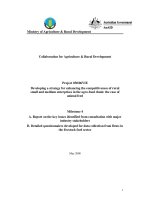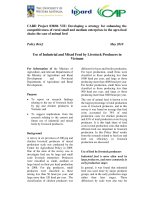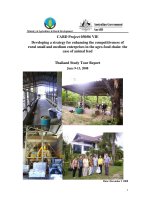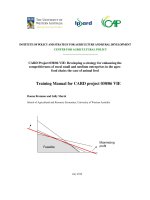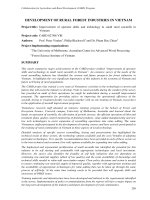Báo cáo nghiên cứu nông nghiệp " Developing a strategy for enhancing the competitiveness of rural small and medium enterprises in the agro-food chain: the case of animal feed " pptx
Bạn đang xem bản rút gọn của tài liệu. Xem và tải ngay bản đầy đủ của tài liệu tại đây (13.31 MB, 6 trang )
Collaboration for Agriculture and Rural Development
(CARD)
Program
262
ENHANCING THE
COMPETITIVENESS OF RURAL SMALL AND MEDIUM
ENTERPRISES IN THE AGRO
-
FOOD CHAIN: THE CASE OF VIETNAM’S
ANIMAL FEED INDUSTRY
Project title:
Developing a strategy for enhancing the competitiveness of rural small and
medium enterprises in the agro
-
food ch
ain: the case of animal feed
Project code
: CARD
030/06 VIE
Authors:
Dr
Nguyen Do Anh Tuan
1
, Pham Thi Lien Phuong
1
, Nguyen Thi Thinh
1
,
Sally
Marsh
2
, Dr Donna Brennan, Prof John Pluske
2
Project Implementing organisations:
1
Center for Agricultural Policy (
CAP)
-
IPSARD
2
University of Western Australia
SUMMARY
The study provides a comprehensive picture of the animal feed sector in Vietnam (both supply and
demand side) upon data collected from 2 main surveys: feed mill survey investigating the supply side
and producer survey investigating the demand side. The results show that, on the supply side, SMEs
appear to have less competitiveness than large ones. That is reflected in some aspects such as higher
production costs per kg output, using more labor, limi
ted quality control, limited access to capital and
land, and many small enterprises have losses. However, small and medium enterprises also have
strategies to maintain their share in the market. Several strategies are used including: focusing on
production
of concentrate feed rather than complete feed as the large enterprises do; selecting plant
locations in rural areas to use domestic supplies of raw material inputs; supplying products mainly for
small producers; provision of credit, delivery services.
On
the demand side, larger pig and chicken producers are more likely to use a higher percentage of
industrial feed in their livestock diets. In term of production cost, industrial feed is shown to be a more
cost
-
effective diet for chicken producers. However,
there is some evidence supporting the cost effective
use of mixed feed
–
particularly for pig production. Another noticeable result is that few surveyed
producers were found to be using domestic brands of industrial feeds. Foreign brands were clearly
prefe
rred by both pig and chicken producers. The main reason given for this choice by producers was
that foreign brands were considered to be of higher quality and give better productivity. This once
again mentions about issues related to quality control of SME
s.
Based on the main findings of the study, some policy recommendations focusing on investment, scale
increase, quality control are given to policy makers and SMEs as well.
1.
Introduction
In Vietnam’s agriculture sector, livestock plays
a very important
role with its share ranging
from 22.6 to 25.5% annually and is considered
as one of the important pillars of a sustainable
development strategy. Over the last years, due
to the effects of the urbanization process and
CARD
030/06
–
Enhancing rural SME competitiveness in animal feed sector
263
income growth, the demand for meat has
increased substantially. This leads to a shift in
the production structure of agriculture from
cultivation to livestock and services. However,
in livestock production, high cost and poor
quality of animal feed are big problems. One
of the best solutions i
s to improve quality and
reduce cost production of animal feed as well
as increase income for the rural areas through
enhancing competitiveness of SMEs.
Up to now, few studies have analyzed the
economic effectiveness of SMEs, and
especially no study has be
en done on assessing
the competitiveness of SMEs in comparison
with large, foreign
-
owned or joint venture
enterprises in Vietnam and other enterprises in
the world. Because there has not been much
investigation of agro
-
industrial SMEs, there
are many unans
wered questions about the level
of competitiveness, whether constraints to
competitiveness can be overcome, and whether
policy changes can encourage the development
of SMEs in this sector. The study of
competitiveness will answer more general
questions abo
ut the nature of economies of
scale in the industry, factors affecting the costs
of production and marketing of animal feed,
and will lead to policies that enhance the
competitiveness of the sector.
2.
Objectives
and
M
ethod
ologies
2.1.
Objectives
Unders
tanding the role and performance
of SMEs in the animal feed sector in other
countries, draw lessons from their
experiences and apply for conditions of
Vietnam;
Providing a quantitative assessment of the
factors affecting the competitiveness of
the animal f
eed industry in Vietnam; and
Providing policy recommendations to the
government with regard to the efficiency
of firms operating in the livestock feed
sector, and provide advice to SMEs
competing in the livestock feed sector
.
2.2.
Research Methodologies
There are two main surveys conducted under
the study
2.
2.1
Feed mills survey
This survey aims at providing a general picture
of the Vietnamese feed sector with a focus on
comparing SMEs and large enterprises with
regards to the production and business
acti
vities of enterprises such as material input
use, storage, product types, quality control, and
type of customer. These activities give
indications of how SMEs compete with larger
feed mill enterprises. Sixty two mills were
surveyed in seven provinces in
three regions:
Ha Noi, Ha Tay and Hung Yen provinces
located in the Red River Delta; Binh Duong
and Dong Nai in the South East; and Tien
Giang and Long An in the Mekong River
Delta. The mills have been categorized in the
following way in the analyses by p
roduction
scale: small mills are those producing less than
10,000 tons per annum; medium mills are
those producing from 10,000 to less than
60,000 tons per annum, and large mills are
those producing 60,000 or more tons per
annum. Only data from 44 mills we
re able to
be used in analyses by production scale
because of data unreliability.
2.2. Producer survey
A survey in six provinces of 300 pig and
chicken livestock producers of mixed
production scale was conducted aiming at
investigating feed use by producer
s. Producers
were classified as small, medium or large
based on their per head production in 2008.
For pig producers, small producers were
classified as those raising less than 50 heads
per year, medium producers are those
producing from 50 to 120 heads p
er year, and
large more than 120 heads per year. The
classification of chicken producers was
different for layer and broiler production. For
layer production, small producers were
classified as those producing less than 1000
heads per year, medium produce
rs are those
producing from 1000 to 4000 heads per year
and large as those producing more than 4000
heads per year. For broiler production, small
producers were classified as those producing
less than 500 heads per year, medium are those
producing from 50
0 to 3000 heads per year
Nguyen Do Anh Tuan, Pham Thi Lien Phuong
,
Nguyen Thi Thinh
,
Sally Marsh
,
Donna Brennan
& John Pluske
264
and large as those producing more than 3000
heads per year.
3.
Research results and discussions
3.
1
Livestock feed production
3.1.1
Production characteristics and costs of
production
In this study, statistical evidence was found t
o
show that cost of production was inversely
related to scale of production, with small
enterprises having significantly higher costs of
production per kg of output than medium
enterprises, which had higher costs of
production than large enterprises. Durin
g 2007,
the mean costs of production per kg of output
were 8420 VND, 6340 VND and 5380 VND
for small, medium and large firms
respectively. This alone is not necessarily an
indicator of greater efficiency of larger
enterprises. For example, small
-
medium
ent
erprises were found to produce a higher
share of concentrate as percentage of total
production than large enterprises. On average,
small mills made 37% of their revenue from
concentrate production, compared to 18% for
medium mills and only 11% for large mi
lls.
Over 80% of revenue for medium and large
mills was made from sale of complete feed.
Concentrate production has higher raw
material input costs per kg of output, so cost of
production per kg of total output would
necessarily be higher for those firms p
roducing
more concentrate. Raw material costs made up
about 80% of the total cost of production in
feed mills.
Small firms used 19 labor units for one unit of
output, compared to around 11 labor units used
by both medium and large firms, and this
differen
ce was significant. This may indicate
under
-
utilization of labor by small firms, or
capital substitution by larger firms. It does
indicate that small firms play a role in
providing employment.
3.1.2
Profitability of small
-
medium
enterprises
For overall pro
duction, we found that small
firms made a loss of 70 VND per kg of output
while the medium and large ones made a profit
of 120 VND and 100 VND per kg output
respectively. These results indicate that small
mills are likely to be struggling to remain
competi
tive. The data indicate that they face
significantly higher costs, and sell pig
complete feed at significantly lower prices,
resulting on average in a significantly lower
profit.
3.1.3
Quality control
The fact that advanced international standards
for qua
lity control such as ISO and HACCP
are only applied by foreign
-
owned and joint
venture companies, indicates better quality
control processes for both input materials and
output products from foreign/large companies.
These mills are more likely than domesti
c
enterprises to have a quality control laboratory
doing various tests of raw materials and feed
products, to have separate production lines, to
own automatic cleaning systems and to use
least
-
cost feed ration software. Clearly, there
are quality control i
ssues for domestic mills.
3.1.4
Constraints on production
Small mills tend to have some disadvantages in
terms of accessing loans from different
sources. They are less able to access enough
funds through loans compared to medium and
large mills. Access to
credit was the most
common issues nominated by mills as needing
support from the government: by over 50% of
medium and large mills, and over 30% of
small mills.
Access to land was also the second most
common issue (after access to credit)
nominated by mil
ls as needing support by
government: by over 20% of all mill size
classes.
Forty two percent of firms overall reported
restrictions with the movement of goods, and
more large firms (61%) reported restrictions
than SMEs. Tolls, inter
-
district and inter
-
pr
ovincial roadblocks and “police conduct”
were reasons given for restrictions on the
movement of goods. Of these, “police
conduct” was nominated as the most important
restriction on movement of goods by 67% of
small firms, 33% of medium firms and 75% of
lar
ge firms.
3.1.5
Strategies used by SMEs to compete for
market share against larger firms
CARD
030/06
–
Enhancing rural SME competitiveness in animal feed sector
265
a.
Location
SMEs are more likely to be located in rural
rather than urban areas, and medium
-
size mills
in particular tend to supply customers further
from their produc
tion site, and this customer is
more likely to be a smallholder. This indicates
that some SMEs are focused on supplying
smallholders in areas further from major cities.
SMEs also used a higher percentage of
domestically sourced raw materials for
productio
n. Location in rural areas may assist
SMEs to source these domestic supplies of raw
material inputs, including raw materials used
less often, such as broken rice, groundnut, and
cottonseed meal.
b.
Supply chain differences
The research showed that the
supp
ly/distribution chains operating for SMEs
and large firms in the livestock feed sector are
quite different, indicating that they are
sourcing materials from and targeting
distribution to different market segments.
Unlike large mills, SMEs source some input
s
and distribute products directly from/to small
households. Large mills are more dependent on
imports (e.g. maize) to meet their raw material
requirements, whereas SMEs are more likely
to be able to source sufficient raw materials in
the domestic market.
SMEs are more likely to diversify their
business into trading activities, and in addition
they sell to a wider range of customer types
including other companies, agents and
households. Small mills in particular will sell
direct to farm households, and med
ium mills
target mainly retail agents for their products.
By contrast, large mills distribute their
products almost exclusively for on
-
selling by
wholesale agents and traders, and source raw
materials from private processing businesses
and state
-
owned ent
erprises.
c.
Services to agents and farm
households
SMEs provide different services associated
with the sale of feed products to agents and
farm households. Small mills are more likely
to provide delivery services to agents
(compared to both medium and lar
ge mills).
SMEs are also more likely than large mills to
offer credit/delayed payment option to agents.
3.
2
Livestock feed use
3.2.1
Industrial feed is more often used by
large producers, and more commonly
in early production stages
In general, it was fou
nd that industrial feed
was used more by larger producer groups, and
in the early production stage rather than later
stages. These differences by scale were also
true for the amount of industrial feed used: that
is, larger producers used more industrial fe
ed
(
i.e.
quantity fed per head). Industrial feed
produced by foreign companies was generally
more favored than that produced by domestic
companies, with more than 90% of the
surveyed households choosing both complete
and concentrate feed with a foreign com
pany
brand. The main reason given by producers for
this choice was that foreign brand feeds were
of better quality and gave greater productivity.
3.2.2
Use of mixed raw feed only diets is no
longer prevalent; instead more
complete only and diets using mixe
d
industrial and raw feeds are used
Except for a few households that fed only
mixed feed to their chickens (9% for broiler
and 18% for layer), a large percentage of both
pig and chicken producers used complete feed
only: 53% for broiler and 64% for layer;
and
43% for sow, 77% for piglet and 45% for
porker production. The remainder used both
complete and mixed feed in the daily diet for
livestock. The ratio of concentrate feed in the
total mixed feed was found to be about 27%
overall for chicken producers,
and 17% for
porker production. Mixed feed was used much
more than complete feed by pig households for
all production stages.
3.2.3
Efficiency of industrial versus mixed
feeds
We found that feed conversion ratios
–
the kg
of feed fed per kg of live
-
weight
produced
-
decrease as production scale increases. The
FCR is much lower in households using
complete only rather than mixed feed, possibly
due to better nutrition from complete feed in
the former case, compared to the mixture of
Nguyen Do Anh Tuan, Pham Thi Lien Phuong
,
Nguyen Thi Thinh
,
Sally Marsh
,
Donna Brennan
& John Pluske
266
raw feed types included i
n the latter. The FCR
is also significantly lower in households using
foreign complete feed than those using
domestic brands in the case of chicken (2.94
versus 4.18).
FCRs for pig production using complete feed
were significantly lower for small scale
pr
oducers (2.08) compared to large scale
producers (2.92). The FCR was also
significantly lower for complete feed diets
(2.65) compared to mixed feed (4.06).
The FCRs may be used as a standard measure
of productivity. However if a more productive
feed costs
more per kg, it may be worthwhile
for farmers to use the cheaper feed with the
higher FCR if the net cost per kg of gain is
lower.
In the case of chicken, we found that overall
feed cost per kg of live
-
weight gain is
statistically different between househ
olds
using complete only and mixed feed (22,690
VND versus 27,890 VND
-
which may be
evidence to support the use industrial feed.
On the contrary, in the case of pig production,
the feed cost per kg of live
-
weight gain was
significantly higher for househo
lds using
complete feed only compared to those using
mixed feed overall (23,580 VND versus
20,150 VND only). This case of pig production
seems to support mixed feed use (often using
local residual feeds) as households can reduce
their feed cost by about 3,
400 VND per kg
live
-
weight gain overall.
4.
Conclusions and recommendation
s
4.1
Conclusions
The results support the idea that medium
-
size
mills (i.e. those producing between 10,000 and
60,000 tons per annum) are remaining
competitive; with costs, product
mix and prices
similar to large mills. They have a sales
strategy that targets a different customer base
to large mills (i.e. retail agents rather than
wholesale agents). Small
-
sized mills
(producing less than 10,000 tons per annum)
appear to be under pre
ssure to survive, and
many will need to increase their scale of
operation and improve quality control to
remain in business. Besides, SMEs are more
likely to be located in rural areas and to use
domestic supplies of raw material inputs.
Hence, opportunitie
s may also exist for the
production of niche feed products for smaller
livestock industries in rural areas (such as
duck, local chicken and pig, and beef cattle)
rather than competing against foreign
companies to supply feed for pig and chicken
production.
4.2
Recommendations
Based on the findings of this project we make
the following policy recommendations for
policy makers:
Focus is needed on quality control. If long
term food safety and export potential is to
be reached, the Government of Vietnam
needs
to address quality control issues
associated with the production of
livestock feed products.
Restrictions on the movement of goods
due to irregular police conduct need to be
addressed.
Invest in domestic production of raw
materials used in feed productio
n.
Credit support for SMEs in the sector
should be expanded.
Support and expand the role of the
Vietnamese Animal Feed Association
(VAFA).
Investigate the possible ways the
government may provide price support for
raw materials and livestock feed outputs.
We suggest the following recommendations
for SMEs operating in the sector:
Small mills need to increase their scale of
operation.
Quality control standards need to be
raised.
Continue to explore and exploit niche
market opportunities.
Consider advantages f
rom diversification
and/or a cooperative structure.
Support a strong role for the VAFA.
CARD
030/06
–
Enhancing rural SME competitiveness in animal feed sector
267
Reference
1.
Center for Agricultural Policy, 2010. Small
-
Medium Enterprises in the Livestock Feed
Sector in Vietnam: Vol 1. Livestock feed
production. Report for CARD Proj
ect
030/06 VIE
2.
Center for Agricultural Policy, 2010. Small
-
Medium Enterprises in the Livestock Feed
Sector in Vietnam: Vol II. Feed use by pig
and chicken livestock producers. Report for
CARD Project 030/06 VIE
3.
Policy Brief 1: Competitiveness of Small
-
Medi
um Enterprises in the Livestock Feed
Production Sector in Vietnam
4.
Policy Brief 2: Quality Control in the
Livestock Feed Sector in Vietnam
5.
Policy Brief 3: Constraints Facing Small
-
Medium Enterprises in the Livestock Feed
Production Sector in Vietnam
6.
Polic
y Brief 4: Use of Industrial and Mixed
Feed by Livestock Producers in Vietnam


